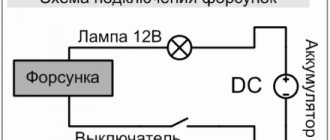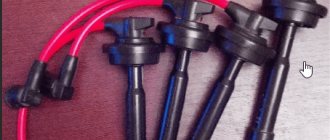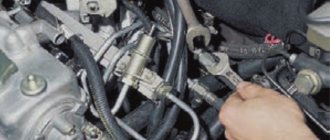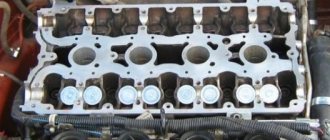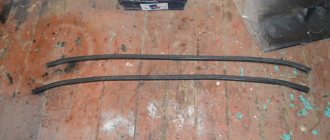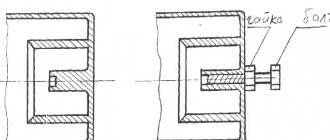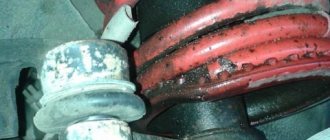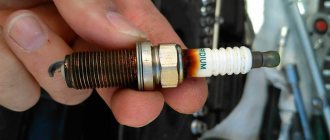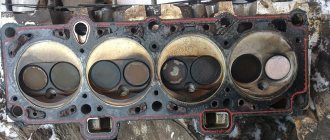All gasoline engines use spark plugs to ignite the fuel mixture, and the VAZ 2110 is no exception. Good and serviceable spark plugs are the key to reliable and stable operation of the car’s power plant. The choice of spark plugs for the VAZ 2110 must be approached wisely, and before installation, the correct gap between the electrodes must be set, but not many people know the necessary parameters for selecting spark plugs and setting the gap.
This article will talk about spark plugs for the domestic “ten”, and specifically talk about their service life, independent replacement, setting the gap and selecting the optimal spark plugs for a given engine.
Candle design
Spark plugs are made of the same type, but often include different components, which allows you to change the technical characteristics of the spark plugs, but in general the elements included in the spark plug remain unchanged.
The candle consists of:
- The contact through which the wire and spark plug are connected;
- An insulator that allows you to maintain voltage from the ignition module without breakdown, and also protects the spark plug from overheating;
- Electrodes, central and side, between these two electrodes a spark occurs, igniting the fuel mixture;
- A ring that contracts, sealing the combustion chamber;
- Threads necessary for reliable fixation of the spark plug in the cylinder head;
Frequency of replacing spark plugs in VAZ 2112
Neither of you has this problem. Thousands of car owners around the world, remembering the wear and tear of the mechanical parts of the car, forget that the parts of the ignition system also do not last forever. The operation of these electronic mechanisms is almost invisible to the driver and is taken for granted.
However, spark plugs need to be changed. The frequency of replacement depends on the design of the spark plugs and the material from which the central electrode is made.
Replacing spark plugs on a VAZ 2112 16 engine valve is carried out every 20-30 thousand km, if these are standard spark plugs with iron-nickel ordinary electrodes. Multi-electrode spark plugs are less susceptible to overheating and electrical erosion, which increases their service life. More modern and expensive spark plugs with iridium and platinum electrodes can work without replacement for 5-6 years and withstand 100 thousand kilometers.
Imagine, this is where you got caught. You remember that the iridium spark plugs were changed more than seven years ago. During this time, you can forget about a lot.
Carefully examining the part in your hand, you discover obvious signs of wear :
- increased gap between the central and side electrodes. This can be corrected by bending the electrode to the desired level. The size of the gap in millimeters is indicated in the marking of the part - it is its last digit. The absence of a number means the gap is 8 mm;
- carbon deposits or deposits on electrodes and insulation. With proper combustion of the air-fuel mixture, the electrodes clean themselves. The nature of the problem can be determined by the structure and color of the coating: - red or brown means that the fuel poured into the car is of low quality; - light, whitish soot - lack of fuel in the combustion chamber; — a thin layer of black soot — the air-fuel mixture is depleted of oxygen. The cause may be a dirty air filter; — a thick layer of black wet deposit means that the spark plug is filled with oil (it smells like an engine overhaul!);
- brown “skirt” on the electrode. The formation of a gap between the metal body of the spark plug and the ceramic insulator allows combustion products to enter there;
- insulation damage. Ceramic insulation becomes covered with a “web” of cracks. Leads to arbitrary deep detonation of the fuel-air mixture, regardless of temperature.
Realizing that replacing one spark plug won’t do the trick, you begin to delve into your memory, trying to remember whether you have recently observed any indirect signs of a malfunction in the car’s operation:
- Difficulty starting the engine and its uneven operation (you probably thought that the problem was in the oil, right?);
- Multiple increases in fuel consumption (“Really, lately the old lady has started eating a lot...”);
- Rough engine operation, reminiscent of detonation (“I didn’t give it any serious attention”);
- Engine stalling at high speeds (“So that’s it!”).
Cursing yourself for inattention and carelessness, you are already mentally preparing to explain to your family that you will be delayed indefinitely... And then you remember that in the glove compartment you have a set of brand new spark plugs, purchased last year specifically in case of a similar problem!
Spark plug gap
For normal operation of a car engine, it is necessary not only to have good and high-quality spark plugs, but also to have a correctly set gap between the electrodes.
The gap between the electrodes is set by bending the side electrode and measuring the distance between the central electrode using a probe.
- For VAZ 2110 injection engines, the gap between the electrodes should be - 1 mm ;
- For VAZ 2110 carburetor engines, the gap between the electrodes should be 0.7 mm ;
Incorrect operation due to faulty ignition coil
Let's move on to the main reasons that cause malfunctions in the car's ignition system.
A common cause of IKZ failure is the influence of external factors; the use of counterfeit spare parts cannot be ruled out. This factor can spoil the function of the ignition system. In cold weather, deterioration in the performance of the ignition system is also noticed.
The main problems include:
- systematic operation of the vehicle in elevated temperature conditions;
- wear of the insulating materials inside the plastic case, as a result of which the current conductivity decreases;
- short circuit of conductors;
- transformer burnout due to low voltage of the on-board network (below 11.0 V);
- mechanical damage to conductor products: breakage, peeling, deformation;
- excessive vibration of the power unit;
- breakage of conductors inside the circuit.
Standard reel - article number and price
Let's look at the articles, the cost of the IKZ, you can navigate by price. Lately, counterfeit parts have become common. By buying such a fake, you reduce its use by half. In order for the car to work well, the choice of parts should be approached with full responsibility.
- 2112-3705010-12 JSC "SOATE", Stary Oskol - 1165 rubles.
- IKZ – 1000 rub.
- 2112-3705010-11 “ITELMA”, Moscow – 1215 rubles.
- 2112-3705010-13 “NORTH”, Novosibirsk – 1515 rubles.
As you can see, ignition coils are affordable and you can purchase them without significant damage to your wallet. How to distinguish a fake from a factory IKZ:
- The first distinguishing feature is that the original reel has a body made of plastic, while the fake one is made of metal.
- The fake part lacks special stamps and a lightning bolt symbol, which indicates high voltage. If you look closely at the contacts of a fake IKZ, you will notice that they are thicker and round. The factory number is marked with an oval on the original part.
Manufacturers and cost of coil analogues
Some individual ignition coils (IKZ) that can be used as analogues:
- “FENOX” (Fenox) - IC16003O7 - KZ VAZ 2110-2112 16kl. + controller M7.9.7 2112-3705010-03 – from 916 rub.
- “France Car” (FranzKar) - FCR220807 - KZ 21120-3705010-10 - from 814 rubles.
- “STARTVOLT” (Startvolt) - SC 0110 - Module for VAZ-2110i-2112i (1.6 l engine, 16 cells) (IKZ) - from 711 rubles.
- “ZOMMER” (Zoomer) - 2112-3705010-12 - KZ 2112, 2170 1.6 16 cl. ZOMMER – from 1100 rub.
- "AVTOVAZ" - 21120-3705010-13 - KZ - from 987 rubles.
- “DELPHI” - 2112-03705010-11 - MODULE 2112 engine, 1.6l ~ 16 valves, engine - from 1000 rub.
- “France Car” (Franz Car) - FCR20V014 - KZ 21120370501011 - from 789 rub.
- "AVTOVAZ" - 21120-3705010-11 - KZ - from 987 rub.
- “ELKAR” - 2112.3705010-11 - KZ V-2110.12 (16 valves) - from 1397 rub.
- “QUARTZ” (Quartz) - QZ21705010 - KZ 2112, 2170, QZ21705010 - from 816 rubles.
“Francecar” fcr20v014 parts are of good quality; this brand is worth paying attention to and it is possible to install it in your car.
Differences between spark plugs for VAZ 2110
Differences in spark plugs for the VAZ 2110 depend on the type of engine. As you know, several engines were installed in the “top ten”, such as: 8-valve carburetor and injection, 16-valve injection.
For 8-valve engines, spark plugs are installed under a 21 mm spark plug head, and for 16-valve engines, under a 16 mm spark plug head. The smaller diameter of the spark plug hexagon for 16-valve engines is due to the fact that the spark plugs in this engine are installed in wells, which makes it impossible to tighten them with a 21 mm wrench.
Checking the condition of the spark plugs
Based on the condition of the spark plug electrodes and threaded part, you can determine whether the engine is operating optimally.
If the top of the spark plug insulator heat cone is light gray to gray in color, then the engine cylinder is operating normally and the fuel injection system is adjusted.
If the top of the heat cone of the spark plug insulator is white, then the ignition timing is incorrect.
Black, soot-like deposits indicate that the spark plug is not reaching its self-cleaning temperature (frequent short-distance driving), incorrect heat rating, too high carbon monoxide content.
Oily layer on the electrodes. Damaged piston rings, valve guides or oil seals. You may have used oil or fuel with additives. In this case, you need to change the oil or fuel with additives and check the condition of the spark plugs again.
This is interesting: Replacing the thermostat on a Niva Chevrolet - photos and videos
Which spark plugs are better for VAZ 2110
AU17DVRM
The original spark plugs for all VAZs are AU17DVRM. These spark plugs from the domestic manufacturer are of excellent quality and have proven themselves well in the market. AU17DVRM are an excellent alternative for replacing spark plugs, as these spark plugs have good spark formation, reliability and durability, and are also not inferior to imported analogues.
NGK No. 11
NGK spark plugs have performed well on the market and are one of the most popular spark plugs for domestic cars. Most Lada owners prefer NGK No. 11 spark plugs. These spark plugs have a long service life and high reliability.
Installation of candles
We prepare new spark plugs for installation for this:
7. Install the spark plug into the cylinder head and screw it in with your fingers until it stops
8. Tighten the spark plug using a torque wrench. Spark plug tightening torque 30.67–39 Nm (3.13–3.99 kgf∙m)
If there is no torque wrench, then tighten the spark plug by turning it 90˚ for a new spark plug and 15˚ for a working spark plug.
Comment. The work is shown on a car with engine 21124. Features of replacing spark plugs on a car with engine 2112 are indicated in the text.
On a car with engine 21124, remove the ignition coil of the first cylinder (see “Ignition coils of engine 21124 (1.6i 16V) - check and replacement”). On a car with a 2112 engine, remove the high-voltage wires from the spark plugs (see.
Signs of faulty spark plugs
Quite often, VAZ 2110 owners are faced with the problem of one of the spark plugs failing. Failure of a spark plug manifests itself with the following symptoms:
- The car's traction disappears;
- One of the cylinders is switched off;
- Engine vibration increases;
- Popping sounds are coming from the exhaust pipe;
- Idle speed becomes much lower than usual;
- The car jerks when driving;
If your car shows such signs of malfunction, you need to check the spark plugs or replace them with new ones.
How to check the spark plug wires of a VAZ 2112 with a multimeter
Before checking with a multimeter, it is worth conducting a visual inspection of the high-voltage line yourself for insulation damage, melting or chips.
Expert advice: Frequent causes of cable breakdowns are careless repairs or contact with hot motor parts. The cause may also be contact with active chemical elements on the insulation.
It is necessary to pay special attention to the contact part of high-voltage wires; they should not show signs of soot and oxidation. During inspection, you can also check for breaks in the high-voltage cable. To check, you need to start the engine and look at the high-voltage line. Sparks will jump at the rupture points.
Checking armored wires with a multimeter
The main problem with wiring is considered to be a problem with the spark plugs due to insufficient voltage. The cause of this malfunction may be:
- broken wires inside the insulation;
- voltage leakage due to poor insulation quality;
- cable resistance is higher than permissible;
- absence or poor contact between spark plugs and high-voltage lines.
In a ruptured high-voltage cable, an electrical discharge occurs, which causes voltage loss. As a result, it is no longer the rated voltage that is supplied to the spark plug, but an electromagnetic pulse.
In order to check the resistance of the high-voltage wires of the VAZ 2112 with a multimeter, you must perform the following procedure:
- Turn on ohmmeter mode.
- Remove the wire from the spark plug of the first cylinder and the ignition coil.
- Connect the multimeter electrodes to the ends of the wire and look at the readings.
Expert advice: In good wires, the resistance should vary from 3.5 to 10 kOhm, depending on the type of wires themselves. Information about resistance is most often indicated on the insulation of high-voltage wires. Check each wire, the spread between them should not exceed 2-4 kOhm.
